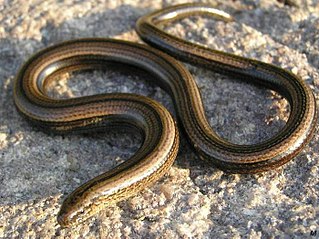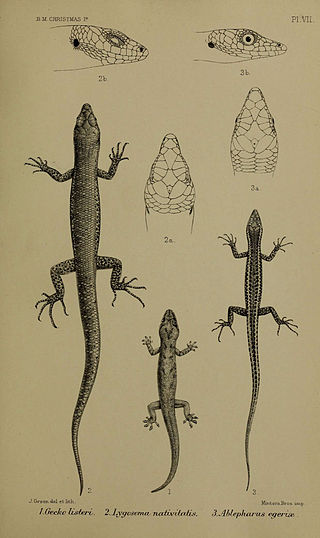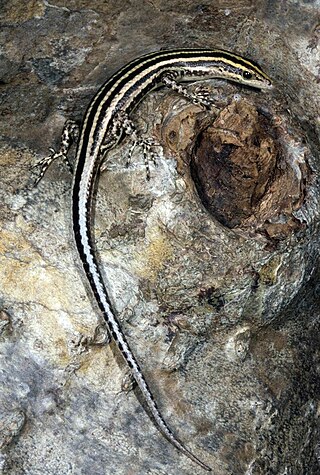
The Komodo dragon, also known as the Komodo monitor, is a large reptile of the monitor lizard family Varanidae that is endemic to the Indonesian islands of Komodo, Rinca, Flores, Gili Dasami, and Gili Motang. It is the largest extant species of lizard, with the males growing to a maximum length of 3 m (10 ft) and weighing up to 150 kg (330 lb).

Lizard is the common name used for all squamate reptiles other than snakes, encompassing over 7,000 species, ranging across all continents except Antarctica, as well as most oceanic island chains. The grouping is paraphyletic as some lizards are more closely related to snakes than they are to other lizards. Lizards range in size from chameleons and geckos a few centimeters long to the 3-meter-long Komodo dragon.

Squamata is the largest order of reptiles, comprising lizards and snakes. With over 12,162 species, it is also the second-largest order of extant (living) vertebrates, after the perciform fish. Squamates are distinguished by their skins, which bear horny scales or shields, and must periodically engage in molting. They also possess movable quadrate bones, making possible movement of the upper jaw relative to the neurocranium. This is particularly visible in snakes, which are able to open their mouths very widely to accommodate comparatively large prey. Squamates are the most variably sized living reptiles, ranging from the 16 mm (0.63 in) dwarf gecko to the 6.5 m (21 ft) reticulated python. The now-extinct mosasaurs reached lengths over 14 m (46 ft).

Monitor lizards are lizards in the genus Varanus, the only extant genus in the family Varanidae. They are native to Africa, Asia, and Oceania, and one species is also found in the Americas as an invasive species. About 80 species are recognized.

Cryptoblepharus is a genus of skinks, lizards in the family Scincidae. The genus contains at least 53 species.

Komodo National Park is a national park in Indonesia located within the Lesser Sunda Islands in the border region between the provinces of East Nusa Tenggara and West Nusa Tenggara. The park includes the three larger islands Komodo, Padar and Rinca, and 26 smaller ones, with a total area of 1,733 km2. The national park was founded in 1980 to protect the Komodo dragon, the world's largest lizard. Later it was dedicated to protecting other species, including marine species. In 1991 the national park was declared a UNESCO World Heritage Site and a Man and Biosphere Reserve. It is considered one of the world's 25 biodiversity hotspots.

The Anguimorpha is a suborder of squamates. The group was named by Fürbringer in 1900 to include all autarchoglossans closer to Varanus and Anguis than Scincus. These lizards, along with iguanians and snakes, constitute the proposed "venom clade" Toxicofera of all venomous reptiles.

Ilya Sergeyevich Darevsky was a Soviet Russian zoologist-herpetologist and a corresponding member of the Russian Academy of Sciences. During his career he described 34 species of amphibians and reptiles. Darevskia, a genus of Caucasian rock lizards, is named after him.
Walter Auffenberg was an American biologist who spent almost 40 years in field research, studying reptile and amphibian paleontology and the systematics and biology of numerous reptile species, including alligators and Komodo dragons.
Richard Sternfeld was a German-Jewish herpetologist, who was responsible for describing over forty species of amphibians and reptiles, particularly from Germany's African and Pacific colonies.

Cryptoblepharus egeriae, also known commonly as the blue-tailed shinning-skink, the Christmas Island blue-tailed shinning-skink, and the Christmas Island blue-tailed skink, is a species of lizard in the family Scincidae that was once endemic to Christmas Island. The Christmas Island blue-tailed skink was discovered in 1888. It was formerly the most abundant reptile on the island, and occurred in high numbers particularly near the human settlement. However, the Christmas Island blue-tailed skink began to decline sharply outwardly from the human settlement by the early 1990s, which coincided with the introduction of a predatory snake and also followed the introduction of the yellow crazy ant in the mid-1980s. By 2006, the Christmas Island blue-tailed skink was on the endangered animals list, and by 2010 the Christmas Island blue-tailed skink was extinct in the wild. From 2009 to 2010, Parks Australia and Taronga Zoo started a captive breeding program, which has prevented total extinction of the species.

Komodo Indonesian Fauna Museum and Reptile Park, is a zoological museum located within the Taman Mini Indonesia Indah (TMII) compound, in East Jakarta, Indonesia. The museum specialized on presenting various collection of the fauna of Indonesia, especially endemic animals of Indonesia, to provides information and education on Indonesian animal diversity. The Komodo Fauna Museum is located on southeast corner of Taman Mini Indonesia Indah cultural park.
The Darmandville bow-fingered gecko is a species of lizard in the family Gekkonidae. The species is endemic to Indonesia.
Cryptoblepharus cygnatus, also known commonly as Swanson's snake-eyed skink, is a species of lizard in the family Scincidae. The species is endemic to the Northern Territory in Australia.
Cryptoblepharus fuhni, also known commonly as the black-boulder shinning-skink, is a species of lizard in the family Scincidae. The species is endemic to Queensland in Australia.
Cryptoblepharus furvus is a species of lizard in the family Scincidae. The species is endemic to Normanby Island in Papua New Guinea.

Cryptoblepharus leschenault is a species of lizard in the subfamily Eugongylinae of the family Scincidae. The species is endemic to Indonesia.

Cryptoblepharus novaeguineae, the New Guinea snake-eyed skink, is a species of lizard in the family Scincidae. It is endemic to Indonesia and Papua New Guinea.
Cryptoblepharus richardsi is a species of lizard in the family Scincidae. The species is endemic to Misima Island in the northwest of Louisiade Archipelago, Papua New Guinea.
William Douglas Burden, was an American naturalist, filmmaker, and author who co-founded Marineland in Florida.












